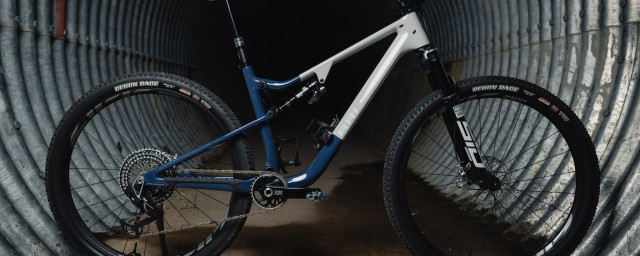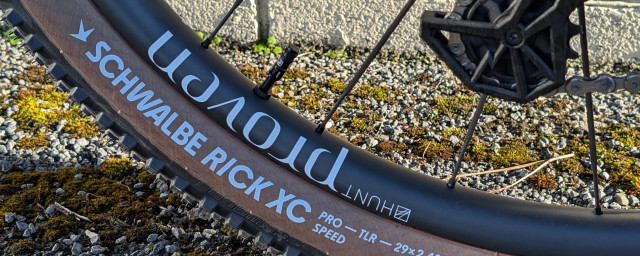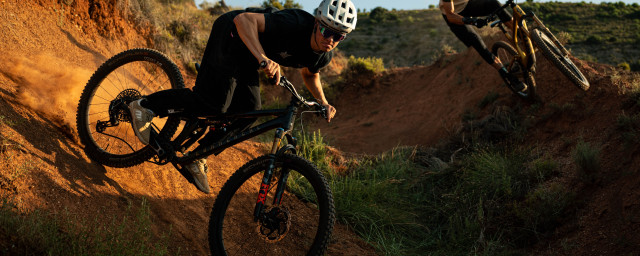Fox Shox officially launches 38 enduro fork, plus huge updates to rest of range

Fox has launched it's long-awaited 38 long travel single crown enduro fork and fully overhauled the existing 34, 36 and 40 fork ranges with new chassis, air springs and damper technology, plus a new channel in the lower casting that increases negative air volume for a smoother, plusher rider.
- Who makes Micro Spline wheelsets for Shimano's 12-speed mountain bike groups?
- The best trail and enduro mountain bike wheelsets, tried and tested
- Your complete guide to SRAM MTB drivetrains, from AXS and XX1 Eagle to NX
[This article was updated 7th April 2020 with Fox's launch information]
The big news here is, of course, the 160-180mm single crown 38 fork which, as the name suggests, gets 38mm upper legs and sits as a full-on enduro fork in between the existing trail/enduro 36 and the dual-crown 40 downhill fork, claiming to be 31% stiffer transverse shear, 17% stiffer fore/aft and 38% torsionally stiffer than a 36.
However, almost all of the new innovations seen on this fork have also been performed on the 36 and 40 ranges as well, making this 2021 update possibly the most comprehensive Fox has ever carried out.
That means all-new lower castings that have a unique way to effectively increase negative air volume, revised GRIP2 dampers available on all models except the short-travel 32 and 34, floating axles, air seal bleeders on most of the long travel range - plus a steerer tube that boosts stiffness on the 38 by having an oval internal profile.
New chassis design gives means less ramp up, more sensitive travel, better lubrication
In recent years, Fox had been coming out second on the fork air spring wars, with RockShox's Debonair spring using some clever internal work on the air shaft to maximise the volume of the negative air chamber that balances the main, positive one to provide a super plush and sensitive start of the travel to maximises grip.
Fox has now responded by creating a new style of lower casting that features an air channel that extends up past the lower bushing. As a fork compresses, the air that's trapped inside the bottom of the lower leg is squashed and this acts like another air spring to the main one, giving a resistance to bottoming-out that the rider can't tune, making it hard to get full travel.
The new channels mean this volume is now much greater and therefore provides less ramp-up effect, meaning the air spring can operate without this interference. It's also allowed them to use a greater volume of lubricating oil in the lower and provides a pathway for that oil to get higher up into the bushings and seals, meaning your fork should stay smoother for longer.
The extra space freed up now means the negative air chamber in the fork is also bigger, giving a smoother and plusher initial stroke. It's a double whammy of improvement - a plusher start to the travel to improve grip and a more easily accessible (and tuneable) ending stroke for control on big hits.
Stiffer with more frame clearance, plus air bleeders
Other chassis tweaks include a much rounder lower arch that's canted forwards to maximise clearance when using short offset versions of the fork on bikes with a chunky head tube - as well as your tyre. The crown has also been beefed up on the 36, which Fox say is to make it integrate more sleekly with the fat tubes of modern trail bikes.
The 36 and 38 forks ranges now also get the air bleeder valves first seen on the 40 series of forks. These allow you to bleed out air that's been trapped in the lower legs as the seals ride up and down and occasionally 'gulp' in air, making the fork less sensitive. Bleeding the air back to atmospheric pressure means it's quick and easy to get them feeling perfect again, without having to resort to the pro mechanic's tip of sticking a zip tie down there.
The 15mm axle system has also seen an update. You still get the choice of a screw-in 'Kabolt' and a quick-release type, but it's now a floating design with the former, secured with an additional pinch bolt. That means a bit more faff to get the wheel in - you need to compress the fork to set it so the legs are perfectly parallel before tightening the pinch bolt - but the result is a stiffer fork. If you prefer convenience over what we assume aren't huge stiffness gains, the QR lever works just the same as before, just now with a sleeve that's secured by the bolt.
The final - and rather cool - piece of the chassis puzzle is seen on the new 38, which counters the flex inherent in a long travel single crown fork by using an elliptical internal profile for the steerer tube.
GRIP2 damper gets new valving
The top-end, four-way adjustable FIT GRIP2 has also seen some tweaks for 2021, namely in that it gets a variable valve control (VVC) in the rebound circuit. Fox says that it "achieves with the twist of a knob what typically requires the time consuming and complicated task of completely disassembling and reassembling the fork."
We're still waiting on the exact details of how that functions, but it's a technology that's been rolled out across their shock range too. It means the GRIP2 forks and X2 shocks now have a matching number of high and low-speed rebound adjustment, which should make setup a less mind-bending affair.
Fox 2021 new fork lineup
All of the new forks are available in high-end Factory, mid-range Performance Elite and e-bike specific models, ut we'll go into detail below. For a bit more explanation of how Fox's lineup works, check out our complete guide to the Fox fork range here.
2021 Fox 38 range
The Fox 38 is available in travels from 160-180mm, in both 650b and 29" wheel sizes. In the former, you can get 37mm and 44mm offsets and in the latter it's 44mm and 51mm. Weights are said to start from 2,180g.
The fork will come in Factory, Performance Elite, Performance and E-Bike models, with the choice of a GRIP2 or GRIP damper - though the Factory will be GRIP2 only.
Prices are said to range from £1,049 to £1,299.
2021 Fox 36 range
The Fox 36 is available in travels from 150-160mm, in both 650b and 29" wheel sizes. In the former, you can get 37mm and 44mm offsets and in the latter it's 44mm and 51mm. Weights are said to start from 1965g.
The fork will come in Factory, Performance Elite and E-Bike models, with the choice of a GRIP2 or GRIP damper - though the Factory will be GRIP2 only.
Prices range from £939 to £1,199.
[Original article is below]
We've heard rumours swirling about Fox creating a long travel riposte to RockShox Lyrik lineup in recent months but understandably no-one has been willing to go on the record with any details. This appearance at the Zermatt round of the Enduro World Series means that Fox is teasing the new design to the public - if they wanted to purely test, they'd do it behind closed doors.
It's slightly but noticeably burlier in all the 'spy' shots that have emerged so far on Instagram and the like. We're pretty confident will be called the 38 because it sits between the current 36 single crown enduro fork and the downhill, dual crown 40 - and because the upper legs will be 38mm in diameter. This is the most logical way for Fox to progress anyway - Fox 39 or 37 doesn't sit quite as nicely.
The forks used by Maes and Rude both were stickered as 36 units but had Fox's RAD (Racing Application Development) logo on them, which has been used on prototype - more accurately pre-production - forks in the past.
These RAD forks also seem to use the same FIT GRIP2 damper seen on the rest of Fox's high-end range. We've no reason to think they'd change this for the 38 - it's a relatively new design and works well, with four-way adjustable damping for high and low-speed rebound and compression.
Detail photos show that it has the air bleed valves seen on the 40 forks on the back of the legs - these allow you to vent any excess pressure that builds up in the lowers as air pressure changes or is 'swallowed' by seals, reducing performance.
Why go to a 38mm chassis?
The big thing here is stiffness. Simple physics tells us that even a small increase in diameter allows a stiffer tube for a given weight. RockShox' Lyrik forks use the same 35mm legs as their lighter-duty Pike fork, but with thicker lower castings and thicker walled tubes for the upper legs, which means a weight penalty for that extra stiffness.
It's likely that moving to a 38mm leg will allow Fox to provide a stiff chassis at longer travel settings - 180mm and upwards, possibly - without hugely increased weight. A stiffer chassis means less flex, less bushing bind and superior suspension performance.
The larger diameter lower leg also means that the air spring on the fork can have a larger negative chamber, which reduces breakaway friction. RockShox achieved this in their Debonair spring on the Lyrik via using the volume inside the air shaft itself to add to the negative chamber, but going to a larger diameter leg means there would be much more volume to play with.
What are the downsides of a 38mm chassis?
It's not all plain sailing when you go to a larger diameter leg diameter. Most of the issues arise from the fact that a larger diameter fork leg needs larger diameter seals and bushings, both of which will increase friction as there's more surface area rubbing against the fork leg. More friction in your fork is a bad thing, for obvious reasons.
It's interesting neither of these RAD forks get the golden Kashima coating seen on Factory spec Fox forks - maybe Fox was hoping that black would be slimming...
The other thing isn't strictly related to the diameter of the chassis but to any long travel single crown fork - make the thing stiffer and you're just putting that bending load elsewhere, with the crown being a particularly highly stressed point. That's why 200mm travel forks have traditionally always been dual crown - it's a better engineering solution to making something stiff and strong, though obviously steering lock is lost. It'll be interesting to see just how much lighter the 38 is than a 40 regardless.
What does Fox say?
We spoke to Chris Trojer from Fox Europe and he said: "In an effort to continually develop highly-advanced suspension products, Fox constantly tests prototype components in the field under the world’s best racers. Some of these components – or parts of them – eventually make it into production, many of them do not. Testing in real-world environments is a critical part of how we determine what works best – not only for our professional athletes but ultimately for every rider who puts their trust in FOX products. This field testing protocol is part of our proven and longstanding RAD (Racing Application Development) program."
That's a neither confirm nor deny, in case you were wondering.
What will happen to the 36 fork range?
It's a very popular fork line for original equipment and aftermarket, so the 36 is unlikely to get totally replaced by the 38 except at longer travels. However, looking at the rest of Fox's lineup can lead to a fairly uneducated guess that there might be some kind of middle in the lineup to split the difference between the 34 and 36 range.
The best way to do that would be to introduce a Stepcast chassis version of the 36, much like the existing Stepcast 32 and 34 which sit at a lighter weight and lower travel than the full-blown 32 and 34 models.
When will the Fox 38 be available?
Fox usually allows the prototype units to be seen a year or so in advance of the actual launch based on our experience of the Stepcast 32 and the 29er version of the Fox 40, so we'd guess that these are 2021 model year products that'll get launched in August-September 2020 thanks to the crazy world of bike industry years.
We'll be updating this as and when we get more information, but it's interesting times in suspension world - will this be able to depose the RockShox Lyrik from enduro rider and racer's hearts and minds? We'll see...


















